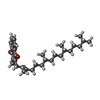+Search query
-Structure paper
| Title | Two-Dimensional Electronic Spectroscopy of a Minimal Photosystem I Complex Reveals the Rate of Primary Charge Separation. |
|---|---|
| Journal, issue, pages | J Am Chem Soc, Vol. 143, Issue 36, Page 14601-14612, Year 2021 |
| Publish date | Sep 15, 2021 |
 Authors Authors | Parveen Akhtar / Ido Caspy / Paweł J Nowakowski / Tirupathi Malavath / Nathan Nelson / Howe-Siang Tan / Petar H Lambrev /    |
| PubMed Abstract | Photosystem I (PSI), found in all oxygenic photosynthetic organisms, uses solar energy to drive electron transport with nearly 100% quantum efficiency, thanks to fast energy transfer among antenna ...Photosystem I (PSI), found in all oxygenic photosynthetic organisms, uses solar energy to drive electron transport with nearly 100% quantum efficiency, thanks to fast energy transfer among antenna chlorophylls and charge separation in the reaction center. There is no complete consensus regarding the kinetics of the elementary steps involved in the overall trapping, especially the rate of primary charge separation. In this work, we employed two-dimensional coherent electronic spectroscopy to follow the dynamics of energy and electron transfer in a monomeric PSI complex from PCC 6803, containing only subunits A-E, K, and M, at 77 K. We also determined the structure of the complex to 4.3 Å resolution by cryoelectron microscopy with refinements to 2.5 Å. We applied structure-based modeling using a combined Redfield-Förster theory to compute the excitation dynamics. The absorptive 2D electronic spectra revealed fast excitonic/vibronic relaxation on time scales of 50-100 fs from the high-energy side of the absorption spectrum. Antenna excitations were funneled within 1 ps to a small pool of chlorophylls absorbing around 687 nm, thereafter decaying with 4-20 ps lifetimes, independently of excitation wavelength. Redfield-Förster energy transfer computations showed that the kinetics is limited by transfer from these red-shifted pigments. The rate of primary charge separation, upon direct excitation of the reaction center, was determined to be 1.2-1.5 ps. This result implies activationless electron transfer in PSI. |
 External links External links |  J Am Chem Soc / J Am Chem Soc /  PubMed:34472838 PubMed:34472838 |
| Methods | EM (single particle) |
| Resolution | 4.31 Å |
| Structure data | EMDB-12697, PDB-7o1v: |
| Chemicals |  ChemComp-CLA:  ChemComp-PQN:  ChemComp-BCR:  ChemComp-LHG:  ChemComp-LMG:  ChemComp-SF4:  ChemComp-ECH:  ChemComp-SQD: |
| Source |
|
 Keywords Keywords | PHOTOSYNTHESIS / Photosystem I / excitation energy transfer / cyanobacteria / minimal structure |
 Movie
Movie Controller
Controller Structure viewers
Structure viewers About Yorodumi Papers
About Yorodumi Papers






